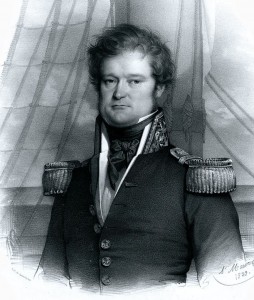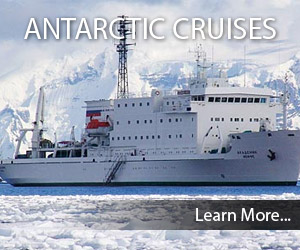11 Jules Sébastien César Dumont d’Urville (1837-40)
It is due to Frenchman Dumont d’Urville that there is a sliver of French territory amidst the giant Australian claim to Antarctica. He called Adélie Land after his wife, and the Adélie penguin (Pygoscelis adeliae) is named for the land he discovered.
Dumont d’Urville was born in Normandy on 25 May 1790 to an aristocratic but poor family. He was an entomologist, a classicist, a botanist, a brilliant linguist, and a respected leader, though somewhat aloof. He joined the French Navy in 1807, was second in command of a Pacific voyage in 1822, and leader of another in 1826. Both voyages were on the same vessel, though for the second Coquille was renamed Astrolabe. He returned in 1829 and wrote his account of the voyage over the next five years.
When Dumont d’Urville proposed another Pacific voyage in 1835 he was 45—old by Antarctic leadership standards. His request was granted and he was ordered to go via the Southern Ocean with ambitious instructions to extend his explorations “towards the Pole as far as the polar ice will permit.” There was a bonus for the crew if they reached 75°S—further south than Weddell’s British voyage of 1823. Dumont d’Urville took two ships, the Astrolabe and the smaller Zélée, with a complement of 183 officers and crew. He sailed from Toulon on 7 September 1837, was delayed by repairs before reaching the Strait of Magellan, but was off the coast of Tierra del Fuego by January 1838.
Unhappily for Dumont d’Urville, and for his bonus-hungry crew, they struck unseasonably heavy sea ice at 59°30´S and had to dodge icebergs at 62°S. On 21 January they were trying to find a way through the pack ice, but by 25 January they had been forced to retreat northward toward the South Orkneys. A storm stopped them landing for fresh seal and penguin meat, and they sailed south again. Encountering pack ice in early February, Dumont d’Urville bravely elected to push into it. They stopped in a stretch of open water and the crew celebrated, but Dumont d’Urville who had been ill for weeks wrote: “I went to bed and could hear their rowdy celebrations … The rashness and imprudence of this move unfolded before my eyes … The only way out was by the way we had come in … was there not reason to fear … ice would completely block our exit?”
How right he was! Before midnight they were ice-bound, and it took five days of hard labor to break into open water. They continued westward, surveying and mapping around Graham Land and the South Shetlands before retreating to Chile, where they arrived ridden with scurvy. Dumont d’Urville wrote: “Either Weddell struck an exceptionally favorable season or he played on the credulity of his readers … As soon as just one other captain has penetrated only five or six degrees further than us in the same area will my doubts be allayed and Weddell right in my eyes.”
When they reached Valparaíso on 25 May, two crewmen were dead and seven others had deserted. But a week later they set out across the Pacific, landing at many islands along the way, and arrived in Australia in March 1839. Early in 1840, after further Pacific exploration (and more sickness), they sailed south from Hobart. They found tabular icebergs at 64°S on 18 January. Their erratic compass suggested that they were close to the Magnetic Pole, but their bad luck with ice the previous season seemed about to be repeated. However, the next afternoon an officer climbed the mast and reported land ahead. After a frustrating few days becalmed, the ships reached the land on 21 January and launched a boat from each ship. On a tiny islet just off the mainland and barely within the Antarctic Circle, the excited boat crews landed, unfurled the tricolor, and collected some granite chips and a few unlucky penguins.
Dumont d’Urville named the area Adélie Land “to perpetuate … my deep and lasting gratitude to my devoted wife.” In an endearingly French footnote, an officer reported that they drank a bottle of Bordeaux wine that someone had brought along “to the glory of France.” They continued westward along the coast for another couple of days, but a bad storm blew up and both ships were nearly lost. It was time to return to Hobart, but there was one more unexpected adventure. On 29 January a ship loomed out of the fog in the east—it was the Porpoise from the American expedition led by Charles Wilkes. The astonished French maneuvered to meet the newcomer, which changed course and departed without contact. Later, the secretive Wilkes claimed that the Frenchman turned and ran; Dumont d’Urville replied: “I would have been glad to give our co-explorers the results of our researches … it seems the Americans were far from sharing those feelings.”
Dumont d’Urville sailed north on 1 February, reached Tasmania’s River Derwent on 18 February, and returned to Toulon on 6 November 1840 after exploring more of the South Seas. The voyage had aged him far beyond his 50 years, but his efforts were rewarded. He was promoted to rear-admiral and given the gold medallion of the Société de Géographie—their highest honor. But he had little time to enjoy his fame. In May 1842 he and his wife and son perished in a train accident—a tragic end to a family whose names would forever be associated with the frozen south.
author: David McGonigal
Thinking of travelling to Antarctica?
Visit our Antarctic travel guide.
Early Explorers
- 01 First speculations
- 02 The Age of Exploration
- 03 Ferdinand Magellan
- 04 Sir Francis Drake
- 05a James Cook (1768-1771)
- 05b James Cook (1772-75)
- 05c James Cook The Final Voyage
- 06 Thaddeus von Bellingshausen (1819-21)
- 07 Who first saw Antarctica?
- 08 Who first set foot on Antarctica?
- 09 James Weddell (1822-24)
- 10 Sealers and whalers
- 10a Biscoe and the Enderby Brothers
- 11 Jules Sébastien César Dumont d’Urville (1837-40)
- 12 Charles Wilkes (1838-42)
- 13 James Clark Ross (1839-43)
- 14 The Challenger Expedition (1872-76)
- 15 Adrien de Gerlache (1897-1899)
- 15 Henryk Johan Bull (1894-95)
- 16 Carsten Borchgrevink (1898-1900)





 Email Newsletter
Email Newsletter